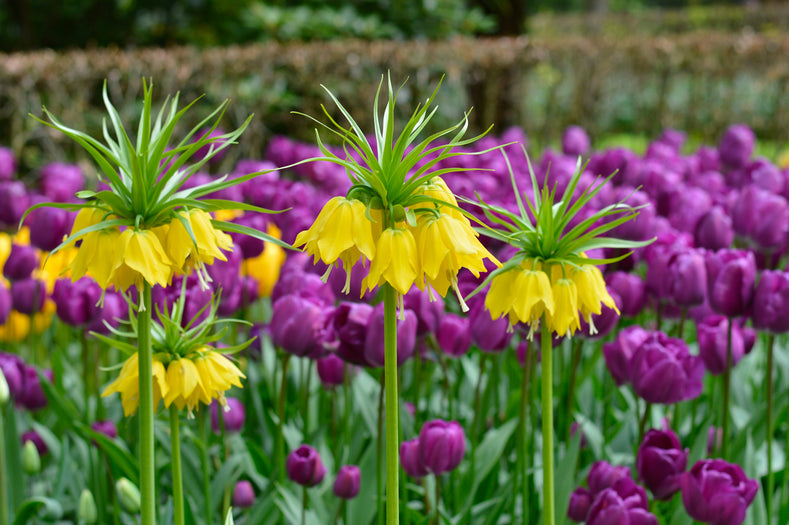Fritillaria, the Versatile Family
Tulips, narcissi, hyacinths, snowdrops…. there are so many beautiful flower bulbs, and they all have their own charm and characteristics. In this blog series we would like to introduce you to a variety of them, helping you to make the best choices for your garden and grow the spring display of your dreams!
Small Surprises and Big Blooms
From the tiny Snake’s Head Fritillary (Fritillaria Meleagris) which is always a delightful surprise to spot in a wild meadow, to the gigantic Crown Imperial which will immediately stand out in any garden, Fritillaria is an enormously diverse flower bulb. Let’s see what we can learn about it!

Plant Passport
- Height
The low-growing Meleagris and Michailovskyi will grow no higher than 10 inches, while whoppers like the Crown Imperial and Persica easily reach 36 inches or more
- Fragrance
All Fritillaria varieties we offer are fragrant. The larger varieties especially have a very strong and musky smell, which pollinators love, but which might be a bit too much for some gardeners.
- Color
Meleagris comes in an endearing chequered purple as well as in red and creamy white, and Michailovskyi wows with its purple bell-shaped blooms with contrasting yellow edges. The Crown Imperial varieties are orangey red and buttercup yellow, while the purple of the Persica is so dark that it’s almost black. Finally, the very special Raddeana blooms in a creamy lime.
- Bloom time
The Persica blooms in mid to late spring, while all other Fritillaria varieties bloom in early to mid spring.
- Longevity
All our Fritillaria varieties are perennial, so when the growing conditions are optimal, they will come back for some years.
- Different types
Roughly speaking, Fritillaria can be divided into two groups: Small and charming varieties like Meleagris and Michailovskyi, and true giants like Crown Imperial, Persica and Raddeana.
- Planting
Fritillaria are hardy in USDA zones 4-8. They grow best in full sun or partial shade, and like all flower bulbs they need well-draining soil to thrive. Once fall has come, it’s time to start planting. The smaller varieties are ideally suited for meadows, rockeries and raised beds, while the giant eye-catchers are great in beds along garden paths or against walls, either as single plants or, for added drama, three together. Plant the smaller varieties 4 inches deep and 3 inches apart and the larger ones 6 inches deep and 8-9 inches apart, and water well. All Fritillaria varieties are deer-resistant, so no need to protect them from any wildlife that may roam in your garden.
- Forcing
The aroma of the larger varieties is a bit too overpowering for indoor forcing, but the smaller varieties are very suitable. In mid-October, plant the bulbs in a well-draining pot, which you then place in a dark space where the temperature is 38°F to 45°F. After 6 to 8 weeks they are ready to be moved into progressively stronger sunlight every week. Your forced Fritillaria will bloom about 4 weeks after coming out of refrigeration.
- Container Planting
Pick a high container, so you can plant the bulbs deep enough. Make sure the container is well-draining. Plant the bulbs as you would in the ground, making sure that they can spend the winter in a consistently cold spot. When the first signs of spring are showing, move the container to a sunny spot and very soon this captivating flower bulb will bloom exactly where you want it to.
- Pricing
Meleagris is an excellent choice for smaller budgets, starting at $0.29 / bulb for 25 bulbs, going down all the way to $0.19 / bulb for a thousand. The other smaller variety, Michailovskyi, retails at $0.72 / bulb for 25 bulbs, but is marked down to $0.54 / bulb for 1000 bulbs. Persica is the most affordable of the large varieties, at $5.80 for one bulb and $3.75 / bulb for a hundred bulbs. The large Crown Imperials costs $6.75 for a single bulb and $4.25 / bulb for 100 bulbs. The very exclusive Raddeana comes to $8.75 for a single bulb, but at 100 bulbs you get a 23% discount, meaning they’ll only cost $6.75 / bulb.
- Combinations
The purple of Persica, Meleagris and Michailovskyi looks great with the bright white of tulips like Royal Virgin and daffodils like Thalia. The Raddeana and the Crown Imperials need a flower that can match their drama, something which the dark purple tulip Vincent van Gogh has plenty of.
Fritillaries For You
Ready for a spring garden full of elegant low-growing blooms or a flower bed being lorded over by a gorgeous giant? Simply place your Fritillaria order on our accessible website and this fall you can expect a delivery of top quality DutchGrown flower bulbs straight to your door!
